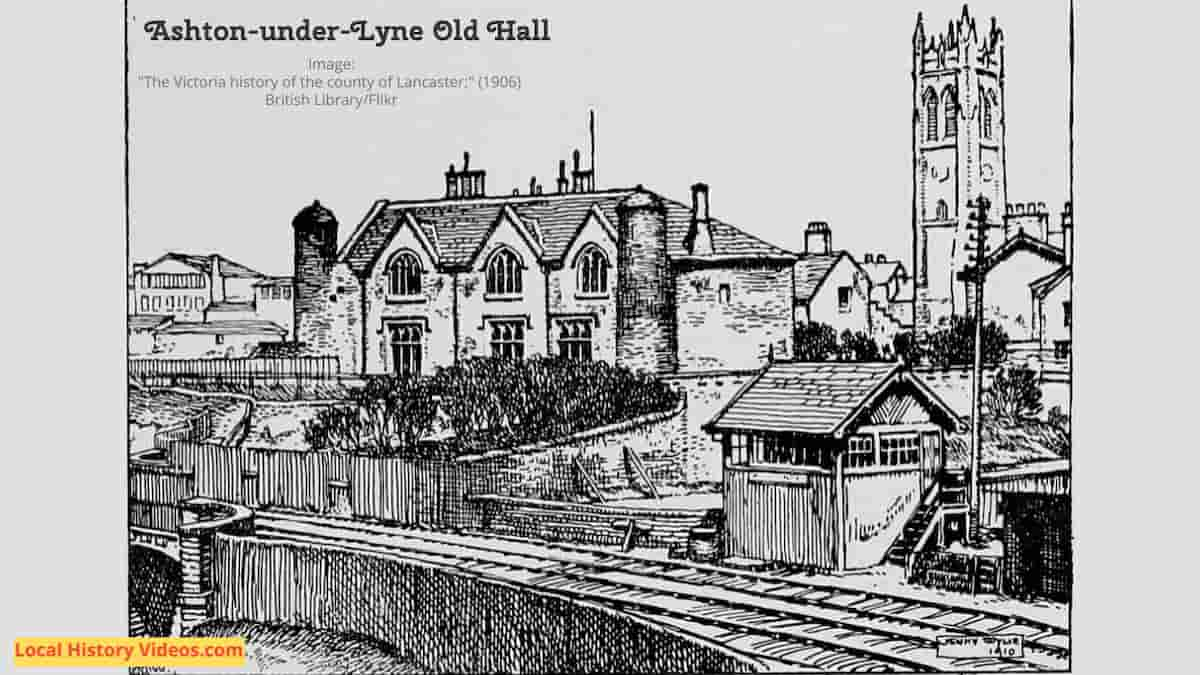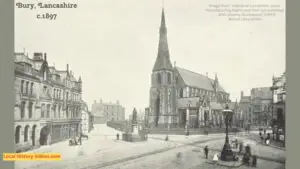Glimpse history through old images of Ashton-under-Lyne, in North West England, UK.
The New MP 1920
British theatre impresario Sir Walter Frece served as a Conservative MP for Ashton-under-Lyne from 1920 until 1924.
To support her husband’s new political career, in 1920 Lady Frece made her last appearance as the celebrated male impersonator Vesta Tilley at the Coliseum Theatre, London, at the age of 56.
In the short newsreel clip, the theatrical duo dressed up smartly in the height of fashion to go and meet men working in their new constituency.
Sir Frece and his wife at Ashton-under-Lyne (1920) – British Pathé on YouTube
Centenary Celebrations 1947
In 1947, the centenary of the borough was celebrated by 50,000 residents, many of whom turned out to watch or participate in the mile long procession.
“With its collieries and great weaving factories, Aston-under-Lyne is today an important centre in the battle for economic survival.”
Along with images of the adults and children taking part, there are also some nice shots of the street on which this event took place.
Ashton-Under-Lyne Centenary Celebrations (1947) – British Pathé on YouTube
Persian Ambassador 1950s
Sometime around 1954, when Iran was still known here as Persia, the ambassador came to visit the National Gas and Oil Engine Co Ltd factory.
This silent footage of the visit includes both exterior and interior shots, as well as clear images of several workers.
From the body language when people talk to each other, you can tell it was a noisy environment.
Then they went on to the Mirrlees Bickerton and Day Limited Diesel Engine Company factory in Hazel Grove.
Three minutes in, the ambassador seems to enjoy his test of a transport trolley, the lightning simulator, and then driving the train.
Persian Ambassador Visits Turbine Works (1940-1949) – British Pathé on YouTube
Terraced Streets 1972
This short footage looking across the roofs and chimney pots of the terraced streets was first shown on TV on 12th October 1972.
Terrace Houses | Ashton-under-Lyne | Smokey Chimneys | 1970s England | This Week – ThamesTv on YouTube
Ashton-under-Lyne 1990
In 1990, three sisters reunited, travelling from their homes in Australia, Canada and the UK. A home video of the town was made for their children. But as with so many of these home videos of the 1980s and 1990s, recording a family trip accidentally created a visual record of people and places no longer here.
Ashton under lyne in 1990. – mercian940 on YouTube
Historic Book
Extract from “An historical account of the towns of Ashton-under-Lyne, Stalybridge, and Dukinfield ” by Edwin Butterworth
Published in 1842
Pages 52-54
“During the seventeenth century , owing to a scarcity
of small coin , tradesmen frequently coined pence , for the
purpose of provincial circulation . Mr. Barritt has pre
served a drawing of one of the trade tokens of Ashton ;
it is thus inscribed on the obverse : – ” George Bardslay in
Ashton – under – lyne , ” and on the reverse ” G. B. E. 1669. “
For nearly two centuries , the seventeenth and part of
the eighteenth , the town underwent but a trifling change ;
in extent , the place was merely a moderate – sized vil
lage ; the houses were chiefly in the immediate vicinity
of the hall and church , and were principally of a rude
construction , being low and thatched . The primitive
methods of spinning and weaving , combined with hus
bandry and gardening , formed the occupations of the
population , whose manners were free and jocose .
In the days of Queen Anne , many of the cottages let
at two shillings each per annum , in consequence of the
non – existence of large manufactories to impart a com
parative high value to property .
As late as the reign of
George II . , 1750 , the whole town was contained in four
narrow dark streets , formed by mean – looking dwellings .
A number of stragglers from the rebel army of 1745 ,
visited the district , and dispossessed a few farmers of
horses .
A serious shock of an earthquake occurred on
Sunday , the 14th of September , 1777 , -the congregation
in the church were much disturbed by the shaking of the
pews . The progress of the cotton manufacture , and the
results produced by its establishment , form the subject
of a separate article .
In the latter part of the last
century the cotton trade was in its infancy , and though
the town was then much increased by means of com
mercial enterprise , the ultimate consequences arising
from the extraordinary spread of trade were not fully
developed until the second or third decennial periods of
the present century .
In the view of the town , published
in Aikin’s Manchester , in 1795 , the appearance is partly
rural and partly town – like , and there seems to have been
scarcely a dwelling south of Old – street , and only two
houses adjacent to Dukinfield – bridge . The buildings
and streets increased rapidly from 1810 to 1824 ; yet in
the latter year , the houses to the west of Mill – lane were
few ; the banks of the canal and the Tame were almost
destitute of dwellings and mills ; the space from Old
street to Charlestown consisted principally of gardens ,
intersected by a foot – path ; west of Oldham – road there
was not one street ; and north of the Old Cross stretched
an expanse of fields to Hurst .
During the last fifteen years the place has rapidly
augmented , so that Mill – lane is nearly become the centre
of the town ; the banks of the canal and the Tame are
now lined by numerous streets ; the area betwixt Old
street and Charlestown is nearly all built upon , and a
portion of it forms a spacious Market – place , on the north
side of which is erected an elegant and large Town Hall ;
the fields formerly bordering on the north of the Old
Cross have been transformed into street avenues ; the
east side of the Rectory has received a large accession of
habitations ; the west side of Oldham – road is become a
portion of the town ; and the vicinities of Henry – square
and St. Peter’s Church abound with new edifices .
When the era of building set in with spirit , a praise
worthy care was invariably manifested to secure regularity
in the plans of the erections ; and hence , by continued
uniformity being preserved in the construction of the
streets , Ashton – under – Lyne has been rendered the most
elegant ordinary town in the county .
The beneficial
system of education pursued in Sunday Schools was first
introduced here in 1790 .
In the course of the afternoon of a dismal day in
January , 1791 , the place was visited by an awful thunder
storm ; a vast accumulation of electric matter seemed to
collect over the town , and between five and six in the
evening , the clouds burst with a tremendous explosion ,
which occasioned an involuntary exclamation of horror
through the place . Lightning struck the church steeple ,
and melted a part of the vane : a number of stones were
thrown from the belfry , where an iron rod was fused by
the fluid , and many pews in the west end of the church
and in the Earl of Stamford’s chapel were shivered to
atoms .
Pages 56
In 1832 the legislature effected an extensive change
in the representation of the people , by granting members
to the principal unrepresented towns : by this measure
Ashton – under – Lyne was constituted a parliamentary
borough . ( See article Representation . ) –
A most afflict
ing event occurred on Sunday evening , the 6th January ,
1833 : six boys were thoughtlessly at play together upon
the ice of a pit at the top of Cricket’s – lane , which , being
but slightly frozen , gave way , and all the juvenile com
pany were immersed in a watery grave ; a middle – aged
man was also drowned in attempting to rescue the boys .
As in all thoroughly manufacturing districts , where
immense numbers of the diligent operatives are employed
by a few enterprising capitalists , lamentable disputes have
prevailed here on the subject of the rate of wages : thus
in 1829 thousands of hands were unemployed for a con
siderable period , owing to the want of an amicable feeling
betwixt the employers and the employed ; whilst some
of the masters , it is probable , have been largely influenced
by the desire of gain , the operatives have been generally
indifferent to their own individual welfare .
A large
number of the factory operatives are intelligent , energetic ,
and active ; but the great mass are of coarse and low
habits .



